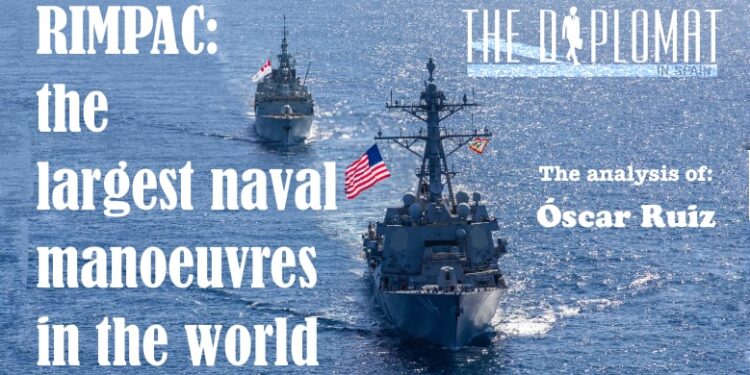RIMPAC military exercises are the largest naval exercises in the world. In addition to its founders – the United States, Australia, New Zealand and Canada – more than twenty countries from Latin America, Europe and Asia participate. The exercise emphasises interoperability and strategic cooperation among the participating nations, contributing to peace and stability in the region.

Óscar Ruiz
Migration expert and international analyst
Every two years, the US Indo-Pacific Command Centre convenes the largest maritime military exercises on the planet. With more than 35,000 participating troops, 29 nations, 46 surface ships, four nuclear submarines and a multitude of air and ground forces, the Rim of the Pacific military exercises, or RIMPAC, are one of the most destructive training events in the world.
Exercises and activities
- Humanitarian Aid and Disaster Relief (HADR). The largest humanitarian aid and disaster response exercise to date, involving eight countries, five ships, five landing craft, five aircraft, multiple ground forces and more than 2,500 participants.
- SINKEX. Live sinking exercise of the old USS Tarawa (LHA-1), a 40,000-tonne amphibious assault ship, to demonstrate the ability to neutralise large amphibious ships similar to those operated by China.
- Other exercises. Anti-submarine warfare, multi-ship surface warfare, multinational amphibious landings and defending a carrier strike group against simulated forces.
Command and Leadership
Vice Admiral John Wade, Commander, US 3rd Fleet, leads RIMPAC Combined Task Force 2024. And, for the first time, a member of the Chilean Navy, Commodore Alberto Guerrero, serves as deputy commander of the Combined Task Force. Other key leaders include Rear Admiral Kazushi Yokota of the Japan Maritime Self-Defence Force and Commodore Kristjan Monaghan of the Royal Canadian Navy.
RIMPAC 2024, which began on 26 June and will end on 2 August, serves to foster and maintain cooperative relations, essential to ensure the security of the sea lanes and support a free and open Indo-Pacific region, and why not, to make clear who is in charge in the Indo-Pacific.
The exercise emphasises interoperability and strategic cooperation among participating nations, contributing to peace and stability in the region.
RIMPAC began as an annual training exercise in 1971 and became biennial in 1974. In its early editions, only a few nations participated, mainly Australia, Canada and New Zealand, along with the United States. It was during the 1980s that participation in RIMPAC began to expand significantly, including more countries from the Pacific region and key partners from outside the region. In the 2000s, the exercise continued to grow, with the inclusion of European and Asian nations, reflecting increased international security cooperation.
- Founding countries: the United States, Australia, Canada, and New Zealand were the first countries to participate.
- Participating nations: In recent editions, the number of participating countries has grown to nearly 30, including Japan, South Korea, India, France, the United Kingdom, and many others.
- Addition of new participants: Over time, nations from Latin America, Europe and Asia have joined, reflecting the global importance of maritime security.
What is RIMPAC for?
Interoperability is one of the main objectives of RIMPAC, between the naval forces of the participating countries, including communication, coordination and execution of joint operations. In addition to this, training and education, RIMPAC provides a platform for training in a wide range of military operations, including anti-submarine warfare, surface warfare, amphibious operations, air defence and humanitarian assistance.
These exercises are also a benchmark for innovation and technology as the exercise serves as a testing ground for new military technologies and tactics, allowing participating nations to test and evaluate their equipment in a multinational environment. In recent years, RIMPAC has included significant humanitarian aid and disaster response components, underscoring the role of the military in emergency relief and assistance.
But military manoeuvres of such magnitude also carry with them controversy and controversy, especially because of their environmental impact. RIMPAC has faced much criticism for its impact on the environment, especially in marine and terrestrial conservation areas in Hawaii, where it has been and continues to be heavily criticised. The maritime training also has political implications, as the participation of certain countries and the nature of some exercises can generate debates about the geopolitical implications of RIMPAC.






